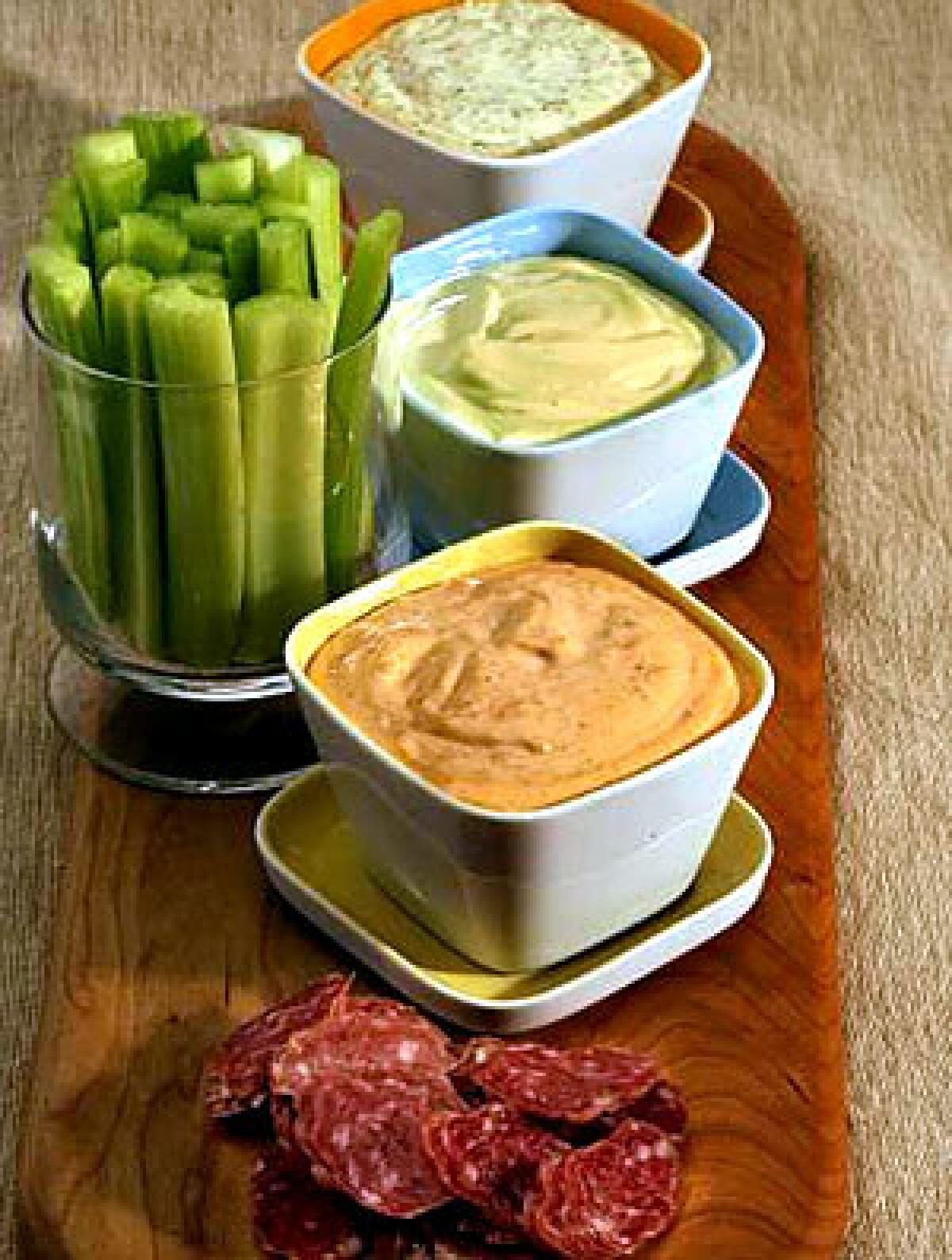A mayo clinic: basic homemade mayonnaise

- Share via
Eating homemade mayonnaise is the kind of luxurious pleasure -- like eating chocolate in the bath -- that shouldn’t require apology. Rich yet subtle in flavor, with a pillowy texture, homemade mayo is nothing like the pale, cloying stuff you get out of a jar.
It dresses up too. Spiked with chiles or shot with saffron, mayonnaise is the perfect secret weapon for a tapas party.
Mayonnaise is a notoriously breakable emulsion, or combination of two liquids (such as oil and water) that can’t be mixed but can be held together in a kind of suspension. But it’s easy to make if you know some tricks -- and the payoffs are big.
Purists make mayonnaise by hand, but successful recipes for blender mayonnaise have been around for years. Now, with the wide availability of good immersion or wand blenders, it’s a great time to update the technique.
Back in the day of 19th century French chef (and sauce expert) Antonin Carême, mayonnaise was made by stirring vinegar and egg yolks with small increments of oil -- relentlessly, with a wooden spoon, for upward of 15 minutes -- until the sauce slowly came together.
The oil droplets bond with the water-based liquids -- traditionally just the yolks and vinegar -- and as the droplets become smaller and smaller, the mixture combines, or emulsifies, until the mayonnaise is thick, custardy and as yellow as butter.
When you make mayo in a blender, the principle is the same -- oil is slowly added to the yolk-vinegar mixture -- but the whirring blades make the process far easier.
Making mayonnaise using an immersion blender may be the coolest technique yet -- at least until they figure out how to make it in a Pacojet. Or a particle accelerator.
With an immersion blender, the process is even faster and you can see the unfolding chemistry, like a sudden, beautiful lab experiment.
Hervé This, author and co-founder of the approach to cooking often called molecular gastronomy, loves to play with mayonnaise. “There is a wonderful experiment that you can make easily,” This wrote in a recent e-mail.
“Make a mayonnaise with a fork and a lot of vinegar [and egg yolk]. The result is not very firm, and quite acidic. Then, in the middle of the bowl, put a plunging mixer and [turn] it on for some seconds. Immediately you get, under the place where you mixed, a very firm sauce, more white, less acidic. Under the microscope you see that the droplet size was divided by 10 to 100!”
You don’t have to be a molecular gastronomist to be wowed.
To make immersion blender mayo, first allow your ingredients to come to room temperature (this is crucial). Place them in the beaker that came with the blender or in a liquid measuring cup or jar with tall, narrow sides.
Place the blender wand in the container and hold it upright against the bottom. Then slowly pour in a cup of canola or other neutral oil (don’t use olive oil at this stage; it’s expensive, more difficult to emulsify and often turns bitter when mixed in a blender), allowing the oil to settle on top.
Pulse the blender, briefly and on high speed if it has adjustable speeds. Continue to pulse, and watch as the pale mayonnaise begins to bloom up through the oil.
Pulse a few more times, until the pale clouds rise up and overwhelm the oil like an establishing weather front.
When the container is mostly cloud-filled, plunge the blender to incorporate the remainder of the oil.
At this point you have a very stable emulsion, and you can continue to add oil -- you could theoretically add quite a bit more, according to Harold McGee, another mayonnaise-happy chemist, as long as the ratio of oil to water-based ingredients is 3 to 1 by volume -- to the sauce without it breaking.
If, however, the sauce does break, you can start over -- or reemulsify the sauce by adding the broken mixture, very slowly, into a new egg yolk.
Once the ingredients have emulsified, I like to gently whisk in good-quality olive oil and fresh lemon juice. The floral notes of the olive oil and the tart bite of lemon enhance the flavor and smooth out the texture, making it creamier. (Lemon juice added at the beginning instead of water makes an oddly rougher sauce, less pale and velvety, more likely to separate; the water makes the sauce lighter and smoother.)
The sauce is now a classic basic mayonnaise, ready for spreading on sandwiches, adding to salads or dressings, spooning over fish before roasting, or serving in a bowl alongside a basket of hand-cut French fries.
Mayonnaise is also a fantastic base for any number of dipping sauces. Stir in fresh minced cilantro or a purée of roasted piquillo peppers, and watch as the pale yellow sauce becomes confetti-flecked with emerald or deepens into rich red hues.
More to Read
Sign up for The Wild
We’ll help you find the best places to hike, bike and run, as well as the perfect silent spots for meditation and yoga.
You may occasionally receive promotional content from the Los Angeles Times.











